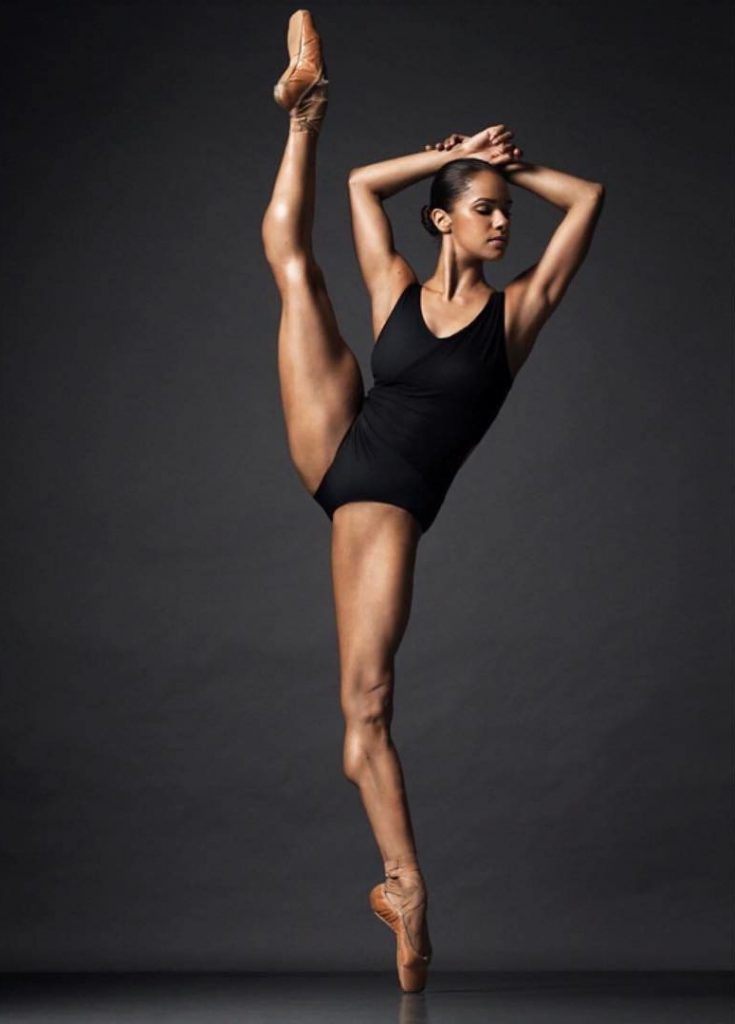“Et un et deux et trois” (and one, and two, and three), are the countless hymns that a typical ballet dancer hears from the rise of dawn to long after sunset. Their long hours in the studio, being constantly on their feet (known as releve), becomes their everyday regime, including exaggerated arm extensions and feet so numb that they do not even feel the blisters from their point shoes; these are examples of the sacrifices and commitments that young ballet dancers experience to make the top one percent that become professionals. An aspiring young African-American woman named Misty Copeland was born to break all barriers in the dance world and change the image of what a ballerina should look like. Misty grew up in a household of five siblings, to a mother of multiple marriages, and to a father who was nearly absent from her life for twenty years; she became American Ballet Theater’s first African-American ballet dancer.1 She is world renowned for her acclaimed performances and the statuesque perfection that has made her an elite dancer. Growing up, she never realized her potential, because of her constant fight for her mother’s attention among her other siblings. Copeland soon realized her passion for dance when she performed dance routines at home to a Mariah Carey chart topper. With no formal ballet or gymnastics experience, she tried out for her middle school drill team, following in her older sister’s footsteps; the elite dance team was recognized for winning countless statewide competitions.2

Even though Misty’s frame was regarded as petite, at thirteen years old Misty was able to use her assertiveness that she gained at home to become captain of the drill team. She was praised for her natural grace and finesse on the dance floor, which later came to the attention of her classically trained coach, Elizabeth Cantine. Off the dance floor, Copeland struggled with the difficulties that her family was enduring. In the year 1994, after her mother’s various friends and boyfriends, her family moved into a small two bedroom Inn in Gardena, California. Along with her brothers and sisters, Misty slept on the floor with only blankets. She regards this memory as, “The hardest time in my childhood,” saying that she made up for the chaos at home by working doubly hard at school.3
Misty’s dance career began at a later age than that of most elite dancers; the average dancer begins training between the ages of four and eight, but her formal training did not begin until age thirteen. Copeland’s middle school drill team coach encouraged her to attend the Boys and Girls Club, where a ballet instructor, Cynthia Bradley, taught free ballet classes once a week. Misty originally declined the offer because her mother did not have a car, and was working twelve to fourteen hours a day, and her oldest sister Erica was working two jobs. But Instructor Bradley began picking Misty up from school. Copeland was able to demonstrate how others’ preconceptions can be disproved with raw talent, “You can start late, look different, be uncertain, and still succeed.”4 Within her brief three months of training with Bradley, Copeland had mastered the French technique of en pointe, which signifies standing on the tip of your toes in ballet shoes, something that takes most ballerinas years to master. As her training became more intensive, Misty began spending most of her hours at the studio, which angered her mother, who told her that she would have to give up ballet. However, Bradley saw a spark of passion in Misty, and offered to host her during her training, as many trainers do for professional athletes. Her mother concluded that it was the best option, considering that their home life was unstable. Copeland explained that the feel of slippers and leotards gave her a sense of confidence and empowerment; she felt like she finally fit in. She had a place to call home and a sport to idolize: “Ballet was so structured. I’d been craving something that could guide me.”5 In the year 1998, at the age of fifteen, she won first prize in the ballet category of the Los Angeles Music Center Spotlight Awards.6

However, that same year a custody battle ensued between the Bradleys and Copeland’s mother. Misty had to return home to her mother, and they had frequent arguments. Her mother had long resented the Bradleys’ influence of homeschooling, Christian religion, and far more personal attention with Misty, and ultimately she decided that Misty would have to cease her continuation with the Bradleys. Misty was distraught with the fear that she would not be able to continue her dance career. The Bradleys then helped Misty to emancipate herself, which was a procedure common among young performers for securing their financial and residential independence. After Misty’s mother received the emancipation documents, she hired famous feminist attorney Gloria Allred and applied a series of restraining orders, which included the Bradleys’ five-year-old son. The order was partly intended to preclude contact between the Bradleys and Misty, but it did not have proper legal basis, since there had been no stalking or harassment.7 The custody controversy was highly publicized in the press: “The attention was devastating,” she says. “I had been so private. It was scarring.”8 After Misty’s mother stated that she would make sure Copeland could dance, both emancipation papers and restraining orders were dropped.
Copeland then began attending San Pedro High School, and continued to study at Lauridsen Ballet Centre in Torrance, California. In 2000, Copeland won another full scholarship, this time to American Ballet Theater’s intensive summer program; and soon after, she became the only African-American woman in a group of eighty dancers. Though she was challenged by her difference, not only her skin color but also her body type, always more full figured than her peers, she nevertheless climbed the ranks by virtue of her exceptional skill.9 In 2007, she became the company’s first African-American female soloist in two decades, with notable performances in The Firebird (2012), in Le Corsaire (2013), and in Swan Lake (2014), to name a few. Copeland’s inspiring story made her a role model and pop icon. She is a New York Times Bestseller in Ballerina Body, a memoir Life in Motion, and Firebird, an inspiring children’s book that shows that through hard work and dedication any young dancer can become a Firebird.10 “I had moments of doubting myself, and wanting to quit, because I didn’t know that there would be a future for an African-American woman to make it to this level. At the same time, it made me so hungry to push through to carry the next generation. So it’s not me up here and I’m constantly saying that it’s everyone that came before me that got me to this position.”11
- Encyclopedia Britannica, 2016, s.v. “Internet,” by Naomi Blumburg. https://www.britannica.com/biography/Misty-Copeland (accessed February 18, 2018). ↵
- Kristen Mascia, “Misty Copeland on Love, Life, and Leaps of Faith,” Elle Magazine, May 29, 2014, 1. ↵
- Kristen Mascia, “Misty Copeland on Love, Life, and Leaps of Faith,” Elle Magazine, May 29, 2014, 1. ↵
- Misty Copeland, Life in Motion (New York: Scholastic Inc, 2017), 262. ↵
- Kristen Mascia, “Misty Copeland on Love, Life, and Leaps of Faith,” Elle Magazine, May 29, 2014, 1. ↵
- Encyclopedia Britannica, 2016, s.v. “Internet,” by Naomi Blumburg. https://www.britannica.com/biography/Misty-Copeland (accessed February 18, 2018). ↵
- Misty Copeland, Life in Motion (New York: Scholastic Inc, 2017), 263. ↵
- Kristen Mascia, “Misty Copeland on Love, Life, and Leaps of Faith,” Elle Magazine, May 29, 2014, 1. ↵
- Encyclopedia Britannica, 2016, s.v. “Internet,” by Naomi Blumburg. https://www.britannica.com/biography/Misty-Copeland (accessed February 18, 2018). ↵
- Macey Morales, “Acclaimed Author, Ballerina Misty Copeland to serve as 2018 National Library Week Honorary Chair,” American Library Association. December 5, 2017, http://www.ala.org/news/press-releases/2017/12/acclaimed-author-ballerina-misty-copeland-serve-2018-national-library-week. (accessed February 18, 2018). ↵
- The Biography.com website, Misty Copeland Biography, https://www.biography.com/people/misty-copeland (accessed February 18, 2018). ↵



87 comments
Montserrat Moreno Ramirez
Persistence is one of the keys to success and I’m glad to know that even though the had many obstacles, starting with her mother which I can Imagine was the biggest one, she was able to overcome it and became an icon for many ballerinas. It doesn’t matter where you come from, but the effort and actions you have to achieve those goals. It was a really interesting article and really liked it.
Belene Cuellar
This article is truly inspiring and very well written with plenty of details about Misty’s life. She is truly a hard worker for never giving up despite her background and the constant bullying about her being different for the other dancers. It’s a bit disappointing to see her mother not being supportive and trying to get her to quit her dream, but I’m glad she had people looking out for her.
Daniela Martinez
Reading Copeland’s story is truly inspiring. Despite the fact that she didn’t have formal ballet training until 13 and still succeed shows her passion for dancing and the dedication she had. I think that her story is one that can help inspire other girls who aren’t sure if they to can achieve their dreams. Copeland’s achievements in the ballet world are truly admirable and the fact that she fought so had hard to do what she loves.
Katherine Watson
Misty Copeland is indeed the face of modern-day dance with her contemporary style and rhythm. Her views on skills in ballet, especially when it comes to a dancer’s ability to perform, is what makes a real dancer. One of my favorite quotes from Misty is that a [dancer] should not “..be defined by how many fouettes she executes..” and that has been something that sticks with me every time I step into a studio. I am very easily intimidated by dancers who can quickly do 10-15 fouettes whereas I can not nearly do as many but she has made me understand that I bring forth other qualities in contemporary and modern dance. One skill does not define the dancer I am, and I have Misty to thank for that.
Nathalie Herrera
Reading Misty Copeland’s story is interesting because it relates to a somewhat similar discussion I had in class. Which was that, it is easy to do what you love but hard to figure out what you love. For Misty dancing came as a direct passion for her and worked extremely hard to be the best she could be. Although in her case, it was hard to continue this passion of ballet due to her unfortunate circumstances at home. Despite this she was still able to carry on and pursue she knew she was destined to do. Very well written!
Faten Al Shaibi
I believe that talent first and then insistence and hard work make miracles and achieve the hope we aspire to.You have to face the difficulties and solve the problems that are facing our life and never give up what ever happened as Misty and believe that we able to achieve all our dreams Even if everyone thinks it is impossible
Pamela Callahan
I’ve heard the name Misty Copeland before, but I had no idea who she was or why she was so famous. This article was very well written and did an excellent job describing Copeland and her story. I find it inspiring that she was able to overcome the numerous challenges in her life and I’m glad that she did because I think her story will inspire many other people to try and achieve goals that they never thought were possible.
Austin Pena
Congrats for your nomination for best use of images. I enjoyed this article and learning about how Misty defied the odds placed against her to reach her dream. The images included show the beauty of being a ballerina and how the entire form of dance is a work of art.
Rolando Mata
This is a very uplifting story that I personally found to be quite inspiring. I’ve never heard of Misty before reading this article so it did a fantastic job of introducing this character and showed the dilemma and struggles of being the first African American ballerina dancer. the framing of her unwillingness to quit was gripping throughout the article and allowed me to imagine the world at that time through the descriptive writing.
Anais Del Rio
This was a wonderful article to read about how someone who had odds against her was able to overcome them. I have never heard of Misty Copeland before but this article was able to give you a sense of who she was. It was sad that her mother tried to bring her talent down. This is the case for several people around the world who have so much potential but have that one obstacle in front of them. Because of her talent she was able to work hard to climb the ranks in the ballerina world and inspire many others like her.